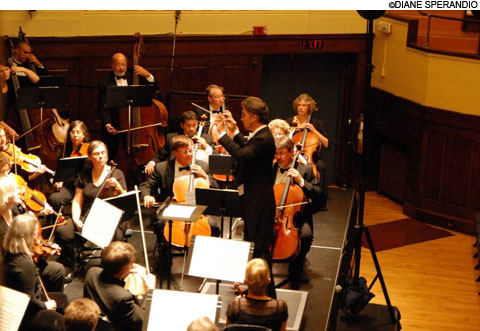 |
Johann Sebastian Bach wasn't the first composer to recycle previous material, but he might have been the first to put together his own greatest-hits album. Conceived in 1733, as an offering to the new Elector of Saxony, Bach's Mass in B minor wasn't completed till 1749, the year before his death, and he borrowed liberally from his cantatas and oratorios to create this affirmation of personal belief, a massive work spanning close to two hours (or more, if you're Otto Klemperer). The outline is familiar — choral outbursts ranging from contrite to ecstatic interwoven with solo statements of the more personal sections of the Latin Mass — but the Baroque-style fugue in the first Kyrie is followed by Palestrina-like Renaissance polyphony in the second, and in the Credo, a plainchant cantus firmus melody acts as a kind of walking bass, a pilgrim asserting his faith in a world whose sound picture is far from reassuring. Even the way the closing "Dona nobis pacem" reworks the melody of the Gloria's "Gratias agimus tibi" seems more of a question than an answer.The scale of the piece could seem to call for the kind of equally massive forces that dominated performances of Bach's big choral works in the first half of the 20th century, but by 1967, even Klemperer had scaled his EMI recording down to a chorus and instrumental complement of about 50 musicians each. For Emmanuel Music's performance last Saturday, music director Ryan Turner fielded 26 instrumentalists and a chorus of 25, the soloists, as usual at Emmanuel, doubling as chorus members. That should have produced a lucid, energetic, moving statement of this work, but Turner's direction was sometimes careful to a fault, the soloists struggled to make an impact against the orchestra, and the enunciation of the chorus (which included such local luminaries as Jayne West, Frank Kelley, and Jason McStoots — and they weren't even soloists!) wasn't always gratifying. Perhaps the right balcony at Emmanuel Church (the center is given over to the organ loft) was wrong place to sit and the floor would have provided a better acoustic.
Not that there wasn't much to admire, and even love. Orchestral highlights included Peggy Pearson's lush, insinuating oboe d'amore in the "Qui sedes ad dexteram patris" section of the Gloria, Whitacre Hill's autumnal horn in the "Quoniam tu solus sanctus" that followed, Vanessa Holroyd's sensuous flute in the "Benedictus" section of the Sanctus, and the trumpets (Greg Whitaker, Paul Perfetti, and Stephen Banzaert) — squealing as if they were cherubim and seraphim having their bottoms pinched — and timpani (John Grimes) throughout. Of the 12 soloists, only alto Krista River in the Agnus Dei made a strong impression; you could hear the catch in her voice when she came to the words for sins, "peccata" — perhaps because she was singing against a very quiet orchestra. The rest sang beautifully but didn't register with much individuality.
Turner started the opening Kyrie at a deliberate, penitential pace and tried to build a big arc, but the result sounded sculpted rather than sweeping, and later, in the Credo, his continuo group seemed to give us Bach by the numbers. Against that, the dark-vale-of-tears "Et incarnatus est" offered a lilting dance pulse (the 3/4 and 6/8 sections had more flow in general), and there was no lack of noisy exuberance in the "Et resurrexit" and "vitam venturi saeculi."